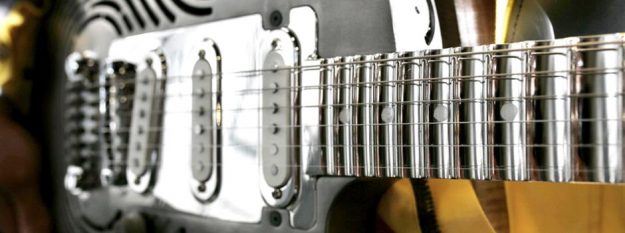
For guitar maker Andy Holt, building guitars out of metal is nothing new. But when Sandvik wanted to produce the world’s first smash-proof guitar, the UK-based designer had to push his skills and imagination to the limit. It was a process that he says sometimes bordered on “madness” but ended up stretching the boundaries of what can be done with milled steel and 3D-printed titanium. And the result was a unique instrument that even rock guitar virtuoso Yngwie Malmsteen couldn’t break.
“I don’t think many people have seen anything quite on the scale that this was done,” Holt told Metalworking World in an interview about the design process. “The way this guitar was produced was brand new, right on the edge of what’s possible.”
By now, the video of Malmsteen’s attempt to smash Sandvik’s all-metal guitar during a rock concert has already gone viral on the internet. But it’s not just the instrument’s sturdiness that is remarkable – its entire design is so intricate that it’s hard to believe that the guitar is made completely out of stainless steel and titanium.
 Holt, whose company, Drewman Guitars, normally makes guitars out aluminium, had caught Sandvik’s eye after being featured in Metalworking World, but when he was first approached by Sandvik’s Let’s Create team about the project, he initially thought it was some prankster making a joke.
Holt, whose company, Drewman Guitars, normally makes guitars out aluminium, had caught Sandvik’s eye after being featured in Metalworking World, but when he was first approached by Sandvik’s Let’s Create team about the project, he initially thought it was some prankster making a joke.
“We get a lot of spotty teenagers who have four pounds and want us to build a 10,000-pound guitar for them,” Holt says. “I thought this was one of those. So I just deleted the email and got on with my day.”
But Sandvik made it clear that this was no joke. The idea was to combine Holt’s expertise in guitar design with Sandvik’s cutting-edge technology and machines to create a fully playable all-metal guitar that could withstand even the most forceful attempts by a rock star to smash it to pieces.
 Holt would have the full power of Sandvik Machining Solutions – which includes Sandvik Coromant – as well as Sandvik’s additive manufacturing unit and Sandvik Machining Solutions, at his disposal. He didn’t need much convincing to get on board with the idea, even though he knew there would be some major challenges to overcome.
Holt would have the full power of Sandvik Machining Solutions – which includes Sandvik Coromant – as well as Sandvik’s additive manufacturing unit and Sandvik Machining Solutions, at his disposal. He didn’t need much convincing to get on board with the idea, even though he knew there would be some major challenges to overcome.
“Everybody knows that the weak point of a guitar is where the neck meets the body,” says Holt. “So I had to figure out a way of designing it so that that wasn’t a factor. That was really the biggest challenge.”
 The solution was to create a unique construction where the neck and fretboard were milled from a single block of steel and extended into a rectangular “hub” that formed the central part of the guitar’s body. That meant there was no joint between the neck and body, the spot that is usually most vulnerable.
The solution was to create a unique construction where the neck and fretboard were milled from a single block of steel and extended into a rectangular “hub” that formed the central part of the guitar’s body. That meant there was no joint between the neck and body, the spot that is usually most vulnerable.
But just when Holt thought he had solved the main design issues, he had to rethink everything. When he started designing, he didn’t know which artist would by trying to smash the guitar. And when Swedish rock legend Yngwie Malmsteen accepted the challenge, Holt had to make the design fit the guitarist’s usual specifications.
“We already had a concept when we found out that Yngwie was on board,” Holt recalls. “And then you just start again, don’t you? Because he’s not going to play anything that doesn’t have all the bits and pieces that he’s used to.”
 That meant changing the design to include three pickups instead of two, three volume controls instead of two and a fretboard that is scalloped in a unique way to fit Malmsteen’s playing style.
That meant changing the design to include three pickups instead of two, three volume controls instead of two and a fretboard that is scalloped in a unique way to fit Malmsteen’s playing style.
Another big issue was finding ways to keep the weight down, as the high-quality Swedish steel being used was much heavier than the aluminium that Holt was used to working with. So the designer went through his computer models in painstaking detail to find any areas where he could shave millimetres of thickness.
“I was sending the Sandvik team new drawings every day for weeks as we were finding things we could shave off and lower the weight – really just so you could lift the thing,” Holt says.
The ”hub” was produced by Sandvik Coromant using recycled stainless steel and a five-axis turn mill. In order to make the guitar as light as possible, Sandvik also used an Isotropic Lightweight Structure (ILS) for the internal part of the neck – hailed as the world’s lightest and strongest steel construction ever. In total, more than 200 different machining operations were used, but all of them in the same turn mill.
 “We used a method where we put raw material into the machine, and out came a finished hub or fretboard. In total we used around 140 kilos of raw materials to produce a guitar neck that then weighed less than three kilos,” says Henrik Loikkanen, machining process developer at Sandvik Coromant.
“We used a method where we put raw material into the machine, and out came a finished hub or fretboard. In total we used around 140 kilos of raw materials to produce a guitar neck that then weighed less than three kilos,” says Henrik Loikkanen, machining process developer at Sandvik Coromant.
Another key component to the milling process was the Coromant Tool Guide, a digital system that uses advanced algorithms to choose the right tools and instruments for a certain process.
“You feed the right parameters into the system, and it will automatically suggest the tools and cutting data that you need,” Loikkanen says.
To further tackle the weight problem, the team decided to make the rest of the guitar body out of 3D printed titanium. But that had its own challenges, as the size limit for 3D printing titanium was a maximum of 400×400 millimeters.
“Guitar bodies are a lot bigger than that,” Holt says. “So then we had to reduce the size of the instrument so that it could be printed and would still fit the bits that were being milled. And that was massively challenging, because that meant we had to change where the volume controls went and the size of the instrument and therefore the weight and the balance and the centre point.”
 The guitar body was then produced by Sandvik’s additive manufacturing unit using some of the most advanced 3D printers in Europe. For Holt, that was a completely new experience, and it was a bit nerve-racking.
The guitar body was then produced by Sandvik’s additive manufacturing unit using some of the most advanced 3D printers in Europe. For Holt, that was a completely new experience, and it was a bit nerve-racking.
“You’re throwing thousands of pounds’ worth of titanium powder into this laser and hoping that a guitar comes out,” he says. “Luckily it worked. So that was brilliant.”
In total, the entire project only took about four months from the first conceptual idea to having a finished project. And that included spending several days with Malmsteen himself in Stockholm going over the design and the materials.
“He was totally engaged,” Holt says. “Really pleasant and polite and thoroughly professional. We’ve all heard stories about rock stars being troublesome to work with, but Yngwie was not. He was great.”
The production phase itself took about a month to complete, which was remarkably quick considering that Sandvik had never built a guitar before.
”For us, the biggest takeaway from this is the incredibly synergy we can create when our different divisions work together,” Loikkanen says. “We have immensely broad expertise in so many different areas that can be used to tackle new challenges.”
Click HERE to watch Yngwie Malmsteen try to destroy the unbreakable guitar.
Click HERE to view Sandvik Coromant | Metalworking World.
Click HERE to view original post from Sandvik Coromant | Metalworking World 08.29.2019


















